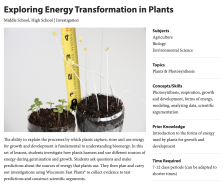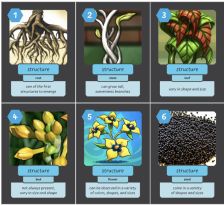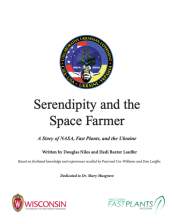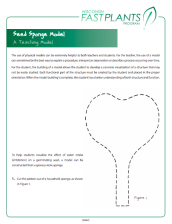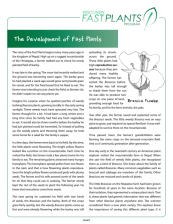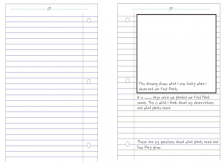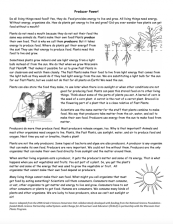Browse Resources
Educational Resources -- Grade Level: Elementary -- Current Elementary Resources
Resources | |
|---|---|
In this set of lessons and Fast Plants experiment, students investigate how plants harness and use different sources of energy during germination and growth. Students ask questions and make predictions about the sources of energy that plants use. They then plan and carry out investigations using...
This activity is designed for teaching the functions of basic plant structures. The activity uses two types of matching cards containing either
a) Structures - depictions of plant structures
b) Functions - descriptions of the function of plant structures
Using the downloadable PDF (including...
This 16-page resource, from Wisconsin Fast Plants, provides a "complete Open Source investigation into ecosystem dynamics that can be adapted to any grade level." In this Google Document, readers will find the investigation includes a lesson plan, descriptions of standards alignment, tips for...
Download this comprehensive, 60-page elementary unit that was co-developed by the Fast Plants Program and Emily Miller (ELA/science elementary science education specialist) who helped author the Next Generation Science Standards) as an exemplar for supporting three-dimensional learning. Developed in...
Who knew that rocket science could have so much in common with botany and plant pathology? This is a human interest and science story that documents from firsthand accounts and artifacts the historical context and scientific events relevant to an important collaborative Fast Plant investigation on...
This 2-page handout gives instructions for making the seed sponge model that was developed by the Wisconsin Fast Plants Program as a tool for learning about germination. Visualizing what is inside a seed and how those structures function during germination is modeled, using a simple kitchen sponge....
This is "The Story of Fast Plants" - a short story of the origins of Brassicas and the work of Dr. Paul Williams, developing Brassica rapa. Reading level ~7th grade.
This document is the step-by-step instructions for planting Fast Plants in a deli-container growing system like is used in Reading Green. The instructions include measurements that are then integrated into mathematics problems that are on the flip side of the planting instructions. The instructions...
Download and print this colorful "Science Inquiry Map" Poster featuring the web of inquiry processes as described by the Five Essential Features of Inquiry from the National Science Education Standards. In addition, the model of inquiry described by the Five Essential Features aligns directly with...
An article written for children, this reading explains the role of plants as producers. It is written at a grade 4-5 reading level, and it is a good supplement to the evidence that students can observe and record through experimentation with photosynthesis.
A 32-page booklet, containing complete instructions for activities at each life cycle stage. The booklet also includes important background information about plant physiology and how to grow Fast Plants. A Growth, Development and Reproduction kit is available. You can also conduct all the...
A 23-page PDF file (644 KB) with a complete set of activities for elementary students (also effective in middle school) to learn about the life cycle of flowering plants with a focus on reproduction. Students predict how many seeds their Fast Plant will produce and engage in planting, growing,...
| |
